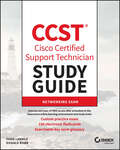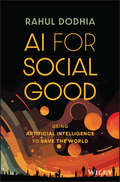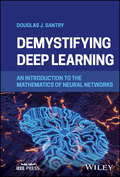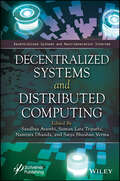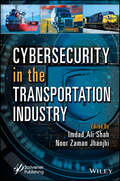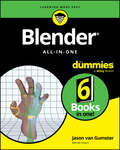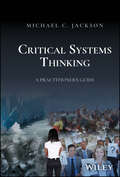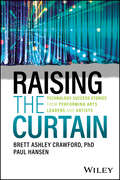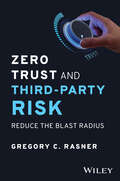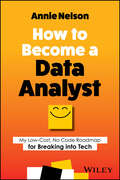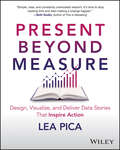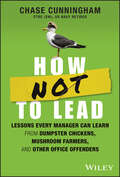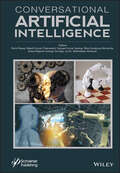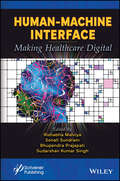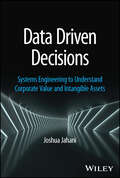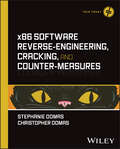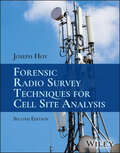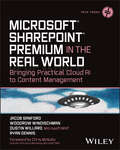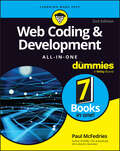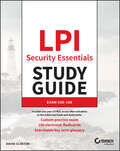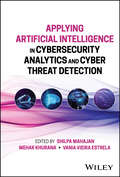- Table View
- List View
CCST Cisco Certified Support Technician Study Guide: Networking Exam
by Todd Lammle Donald RobbThe ideal prep guide for earning your CCST Networking certification CCST Cisco Certified Support Technician Study Guide: Networking Exam is the perfect way to study for your certification as you prepare to start or upskill your IT career. Written by industry expert and Cisco networking guru Todd Lammle, this Sybex Study Guide uses the trusted Sybex approach, providing 100% coverage of CCST Networking exam objectives. You’ll find detailed information and examples for must-know Cisco networking topics, as well as practical insights drawn from real-world scenarios. This Study Guide provides authoritative coverage of key exam topics, including standards and concepts, addressing and subnet formats, endpoints and media types, infrastructure, diagnosing problems, and security. You also get one year of FREE access to a robust set of online learning tools, including a test bank with hundreds of questions, a practice exam, a set of flashcards, and a glossary of important terminology. The CCST Networking certification is an entry point into the Cisco certification program, and a pathway to the higher-level CCNA, so it’s a great place to start as you build a rewarding career! Study 100% of the topics covered on the Cisco CCST Networking certification exam Get access to flashcards, practice questions, and more great resources online Master difficult concepts with real-world examples and clear explanations Learn about the career paths you can follow and what comes next after the CCSTThis Sybex study guide is perfect for anyone wanting to earn their CCST Networking certification, including entry-level network technicians, networking students, interns, and IT professionals.
AI for Social Good: Using Artificial Intelligence to Save the World
by Rahul DodhiaUnderstand the real power of AI and and its ability to shape the future for the better. AI For Social Good: Using Artificial Intelligence to Save the World bridges the gap between the current state of reality and the incredible potential of AI to change the world. From humanitarian and environmental concerns to advances in art and science, every area of life stands poised to make a quantum leap into the future. The problem? Too few of us really understand how AI works and how to integrate it into our policies and projects. In this book, Rahul Dodhia, Deputy Director of Microsoft’s AI for Good Research Lab, offers a nontechnical exploration of artificial intelligence tools—how they’re built, what they can and can’t do, and the raw material that teaches them what they “know.” Readers will also find an inventory of common challenges they might face when integrating AI into their work. You'll also read more on: The potential for AI to solve longstanding issues and improve lives Learn how you can tap into the power of AI, regardless of the size of your organization Gain an understanding of how AI works and how to communicate with AI scientists to create new solutions Understand the real risks of implementing AI and how to avoid potential pitfalls Real-life examples and stories that demonstrate how teams of AI specialists, project managers, and subject matter experts can achieve remarkable products. Written for anyone who is curious about AI, and especially useful for policymakers, project managers, and leaders who work alongside AI, AI For Social Good provides discussions of how AI scientists create artificially intelligent systems, and how AI can be used ethically (or unethically) to transform society. You’ll also find a discussion of how governments can become more flexible, helping regulations keep up with the fast pace of change in technology.
Demystifying Deep Learning: An Introduction to the Mathematics of Neural Networks
by Douglas J. SantryDEMYSTIFYING DEEP LEARNING Discover how to train Deep Learning models by learning how to build real Deep Learning software libraries and verification software! The study of Deep Learning and Artificial Neural Networks (ANN) is a significant subfield of artificial intelligence (AI) that can be found within numerous fields: medicine, law, financial services, and science, for example. Just as the robot revolution threatened blue-collar jobs in the 1970s, so now the AI revolution promises a new era of productivity for white collar jobs. Important tasks have begun being taken over by ANNs, from disease detection and prevention, to reading and supporting legal contracts, to understanding experimental data, model protein folding, and hurricane modeling. AI is everywhere—on the news, in think tanks, and occupies government policy makers all over the world —and ANNs often provide the backbone for AI. Relying on an informal and succinct approach, Demystifying Deep Learning is a useful tool to learn the necessary steps to implement ANN algorithms by using both a software library applying neural network training and verification software. The volume offers explanations of how real ANNs work, and includes 6 practical examples that demonstrate in real code how to build ANNs and the datasets they need in their implementation, available in open-source to ensure practical usage. This approachable book follows ANN techniques that are used every day as they adapt to natural language processing, image recognition, problem solving, and generative applications. This volume is an important introduction to the field, equipping the reader for more advanced study. Demystifying Deep Learning readers will also find: A volume that emphasizes the importance of classification Discussion of why ANN libraries, such as Tensor Flow and Pytorch, are written in C++ rather than Python Each chapter concludes with a “Projects” page to promote students experimenting with real code A supporting library of software to accompany the book at https://github.com/nom-de-guerre/RANT An approachable explanation of how generative AI, such as generative adversarial networks (GAN), really work. An accessible motivation and elucidation of how transformers, the basis of large language models (LLM) such as ChatGPT, work. Demystifying Deep Learning is ideal for engineers and professionals that need to learn and understand ANNs in their work. It is also a helpful text for advanced undergraduates to get a solid grounding on the topic.
Decentralized Systems and Distributed Computing
by Suman Lata Tripathi Satya Bhushan Verma Sandhya Avasthi Namrata DhandaThis book provides a comprehensive exploration of next-generation internet, distributed systems, and distributed computing, offering valuable insights into their impact on society and the future of technology. The use of distributed systems is a big step forward in IT and computer science. As the number of tasks that depend on each other grows, a single machine can no longer handle all of them. Distributed computing is better than traditional computer settings in several ways. Distributed systems reduce the risks of a single point of failure, making them more reliable and able to handle mistakes. Most modern distributed systems are made to be scalable, which means that processing power can be added on the fly to improve performance. The internet of the future is meant to give us freedom and choices, encourage diversity and decentralization, and make it easier for people to be creative and do research. By making the internet more three-dimensional and immersive, the metaverse could introduce more ways to use it. Some people have expressed negative things about the metaverse, and there is much uncertainty regarding its future. Analysts in the field have pondered if the metaverse will differ much from our current digital experiences, and if so, whether people will be willing to spend hours per day exploring virtual space while wearing a headset. This book will look at the different aspects of the next-generation internet, distributed systems, distributed computing, and their effects on society as a whole.
ChatGPT For Dummies
by Pam BakerLearn how the disruptive AI chatbot is going to change school, work, and beyond ChatGPT For Dummies demystifies the artificial intelligence tool that can answer questions, write essays, and generate just about any kind of text it’s asked for. This powerful example of generative AI is widely predicted to upend education and business. In this book, you’ll learn how ChatGPT works and how you can operate it in a way that yields satisfactory results. You’ll also explore the ethics of using AI-generated content for various purposes. Written by a journalist who's been on the front lines of artificial intelligence for over a decade, this book dives deep into ChatGPT’s potential, so you can make informed decisions—without asking ChatGPT for help. Learn how ChatGPT works and how it fits into the world of generative AI Harness the power of ChatGPT to help you, and avoid letting it hinder you Write queries that deliver the kind of response you want Take a look into how the ChatGPT API interacts with other tools and platformsThis just-in-time Dummies title is perfect for anyone life or career may be impacted by ChatGPT and other AI. ChatGPT is just the tip of the iceberg, and this book can help you prepare for the future.
Cybersecurity in the Transportation Industry
by Noor Zaman Jhanjhi Imdad Ali ShahThis book offers crucial solutions and insights on how transportation companies can enhance their cybersecurity management and protect their corporate reputation and revenue from the increasing risk of cyberattacks. The movement of people and goods from one location to another has always been essential to human development and survival. People are now exploring new methods of carrying goods. Transportation infrastructure is critical to the growth of a global community that is more united and connected. The presented cybersecurity framework is an example of a risk-based method for managing cybersecurity risk. An organisation can find opportunities to strengthen and explain its management of cybersecurity risk by using its existing procedures and leveraging the framework. The framework can provide a foundation for businesses that do not currently have a formal cybersecurity program. However, there is a strong temptation to give in when a transportation company is facing a loss of millions of dollars and the disruption of the worldwide supply chain. Automobile production, sales, trucking, and shipping are high-value industries for transportation enterprises. Scammers know that these corporations stand to lose much more in terms of corporate revenue and reputation than even the highest ransom demands, making them appealing targets for their schemes. This book will address the increasing risk of cyberattacks and offer solutions and insight on the safety and security of passengers, cargo, and transportation infrastructure to enhance the security concepts of communication systems and the dynamic vendor ecosystem.
Blender All-in-One For Dummies
by Jason van GumsterCreate excellent 3D animations with free, open-source software When you’re looking for help with creating animation with Blender, look no further than the top-selling Blender book on the market. This edition of Blender For Dummies covers every step in the animation process, from basic design all the way to finished product. This book walks you through each project phase, including creating models, adding lighting and environment, animating objects, and building a final shareable file. Written by long-time Blender evangelist Jason van Gumster, this deep reference teaches you the full animation process from idea to final vision. With this fun and easy guide, you’re on your way toward making your animation dreams a reality. Set up Blender and navigate the interface Learn how to build models in virtual space Texture, light, and animate your figures—then render your final product Get help and inspiration from the Blender community If you’re new to Blender or an experienced user in need of a reference, Blender For Dummies is the easy-to-use guide for you.
GarageBand For Dummies
by Bob LeVitusPut together great-sounding audio tracks on Mac, iPhone, or iPad GarageBand For Dummies gets you started with the popular audio software included with Apple devices. This simple app lets you do everything from building basic beats to creating multi-track recordings. You’ll learn how to build a song from the ground up in this beginner-friendly Dummies guide. Follow simple, step-by-step instructions that guide you through building percussion loops, adding melodies, and recording live vocals or other instruments. When your masterpiece is complete, this book shows you how to mix and master your tracks and get them ready to share with the world. You, GarageBand, and GarageBand For Dummies are about to make beautiful music together. Learn the GarageBand interface and set up recording sessions Set up your recording space to get the best quality audio from vocal and instrument sessions Add beats and loops or perform on built-in instruments Blend your tracks into a final mixFor easily creating recordings and demos using the free GarageBand app, this is the book you need.
Critical Systems Thinking: A Practitioner's Guide
by Michael C. JacksonCRITICAL SYSTEMSTHINKING Understand the full range of systems approaches and how to use them with this innovative overview. Leaders and managers face increasing complexity and uncertainty because technical, organizational, socio-cultural, political, and environmental issues have become intensely interconnected. Systems thinking is recognized as the essential competence for managing complexity. As the demand for systems thinking grows, however, the fragmentation of the field into different methodologies has become a potential liability. Critical systems thinking (CST) shows how this diversity can be a strength rather than a weakness by revealing how different systems methodologies address various aspects of complexity and how they can be used in combination to resolve the messiest of wicked problems. Critical Systems Thinking offers, in a single volume, an account of the value of systems thinking and CST in the modern world, an explanation of the pragmatic philosophy and expansion in mindset necessary to embrace CST, and detailed instructions on how to undertake critical systems practice (CSP) using the variety of systems approaches to navigate multi-dimensional complexity. Readers will find: An accessible introduction to systems thinking and CST. A description and critique of the best-known systems methodologies. A guide to the mindset changes, the steps required, and the toolkit necessary to undertake successful CSP. Case studies and examples of CSP. A discussion of the nature of systemic leadership. Critical Systems Thinking is ideal for leaders and managers in government, business, the public sector, the professions, and beyond who want to understand the potential of systems thinking and use it in their work. It is essential for systems researchers and practitioners who want a deeper understanding of the field.
Raising the Curtain: Technology Success Stories from Performing Arts Leaders and Artists
by Brett Ashley Crawford Paul HansenLearn how emerging technologies benefit artists and performing arts organizations Raising the Curtain: Technology Success Stories from Performing Arts Leaders and Artists focuses on empowering artists and performing arts organizations in theater, dance, and music to grow audiences and to increase impact through smart and strategic uses of technology. This book will help you effectively increase your artistic and administrative reach in order to expand your outreach to diverse audiences, without breaking the bank. In fact, you’ll be more efficient by choosing multi-function technologies that work for you. You’ll also see how advanced software can extend your donor reach—and ensure that you’re contacting donors at the right time. You can also maximize your organization’s brand by incorporating social media, AI tools, media streaming platforms, and more. Inside, you’ll learn about the most useful tech tools out there, including a wide breadth of technology, from Tessitura to A.I., from the success stories of artists such as Emmet Cohen and Jane Monheit, and organizations such as Attack Theatre and The Kennedy Center. Even more importantly, you’ll gain the confidence you need to incorporate technology into all areas of your organization in order to define your path to greater success. Discover software platforms, online tools, and other interactive technologies useful to designers, artists, and arts organizations Save money, expand your reach, and future-proof your performing arts organization or career Lead conversations about technologies and digital opportunities with staff, board members, or donors Get an overview of technology that addresses the unique opportunities and challenges facing the performing arts industry This book is a great resource for performing arts administrators and artists to learn new ideas about technology solutions. Administrators, leaders, and performers alike will appreciate the opportunity to bring art to audiences using today’s latest innovations.
Zero Trust and Third-Party Risk: Reduce the Blast Radius
by Gregory C. RasnerDramatically lower the cyber risk posed by third-party software and vendors in your organization In Zero Trust and Third-Party Risk, veteran cybersecurity leader Gregory Rasner delivers an accessible and authoritative walkthrough of the fundamentals and finer points of the zero trust philosophy and its application to the mitigation of third-party cyber risk. In this book, you’ll explore how to build a zero trust program and nurture it to maturity. You will also learn how and why zero trust is so effective in reducing third-party cybersecurity risk. The author uses the story of a fictional organization—KC Enterprises—to illustrate the real-world application of zero trust principles. He takes you through a full zero trust implementation cycle, from initial breach to cybersecurity program maintenance and upkeep. You’ll also find: Explanations of the processes, controls, and programs that make up the zero trust doctrine Descriptions of the five pillars of implementing zero trust with third-party vendors Numerous examples, use-cases, and stories that highlight the real-world utility of zero trustAn essential resource for board members, executives, managers, and other business leaders, Zero Trust and Third-Party Risk will also earn a place on the bookshelves of technical and cybersecurity practitioners, as well as compliance professionals seeking effective strategies to dramatically lower cyber risk.
How to Become a Data Analyst: My Low-Cost, No Code Roadmap for Breaking into Tech
by Annie NelsonStart a brand-new career in data analytics with no-nonsense advice from a self-taught data analytics consultant In How to Become a Data Analyst: My Low-Cost, No Code Roadmap for Breaking into Tech, data analyst and analytics consultant Annie Nelson walks you through how she took the reins and made a dramatic career change to unlock new levels of career fulfilment and enjoyment. In the book, she talks about the adaptability, curiosity, and persistence you’ll need to break free from the 9-5 grind and how data analytics—with its wide variety of skills, roles, and options—is the perfect field for people looking to refresh their careers. Annie offers practical and approachable data portfolio-building advice to help you create one that’s manageable for an entry-level professional but will still catch the eye of employers and clients. You’ll also find: Deep dives into the learning journey required to step into a data analytics role Ways to avoid getting lost in the maze of online courses and certifications you can find online—while still obtaining the skills you need to be competitive Explorations of the highs and lows of Annie’s career-change journey and job search—including what was hard, what was easy, what worked well, and what didn’t Strategies for using ChatGPT to help you in your job searchA must-read roadmap to a brand-new and exciting career in data analytics, How to Become a Data Analyst is the hands-on tutorial that shows you exactly how to succeed.
Present Beyond Measure: Design, Visualize, and Deliver Data Stories That Inspire Action
by Lea PicaAre you suffering from Data Presentation Zombification? Billions of dollars and thousands of hours are lost every year during ineffective business meetings worldwide. Data practitioners painstakingly present their valuable analytical insights, only to fall flat, inspiring more yawns than yeses. In Present Beyond Measure: Design, Visualize, and Deliver Data Stories That Inspire Action, Lea Pica provides a 4-phase, step-by-step blueprint for planning, designing, visualizing, and delivering compelling data storytelling in business presentations. Following her blueprint, you will learn how to use neuroscience and cinematic storytelling techniques to galvanize your stakeholders into action. By the final page, you'll know exactly how to: Choose the data that matters most to your decision-makers Speak to different stakeholder audience personality types (even the most challenging) Infuse your data presentation with a persuasive narrative storyline Craft strategic recommendations that get approved and implemented Design simple, stunning slides that communicate without confusing Transmit your data story with best-practice data visualization techniques Avoid the most common data visualization violations and charting pitfalls Prepare for and deliver your presentation like a professional speaker Navigate challenging meeting conversations and logistics with easeWhether you work with little or big data, this book will show you how to prevent presentation zombies and inspire the action and credibility you and your organization deserve.
How NOT to Lead: Lessons Every Manager Can Learn from Dumpster Chickens, Mushroom Farmers, and Other Office Offenders
by Chase CunninghamStep Aside, Mediocre Leaders: Learn What NOT To Do! Ditch the fluff and sugarcoating and learn how to lead the way your people deserve. In How NOT To Lead, Dr. Chase Cunningham, a seasoned cybersecurity heavyweight and Retired Navy Chief, doesn't give you a textbook guide on leadership — he delivers a no-holds-barred, gloves-off masterclass on the lethal mistakes that'll tank your leadership game and ultimately sink your reputation and even your company's future. Want the brutal truth? This book slaps you with some cold, hard realities: What happens when you fall off your ego and hit your IQ on the way down as a leader, and why you need to do that. The absolute idiocy of "Mushroom Farming": keeping your team in the dark, feeding them crap, and expecting gourmet results. A nowhere-to-hide deep dive into "Dumpster Chickens" leadership: using destructive tactics that rip apart team spirit and obliterate business success. The triple threat: the three non-negotiable currencies every leader MUST have. Miss one, and you're doomed. Eye-opening case studies — ripped from headlines and history books — that throw a spotlight on the real-world disasters of crappy leadership. Aimed squarely at managers, executives, and anyone brave enough to lead, How NOT To Lead is your audacious guide through the minefield of leadership pitfalls. If you've got the intestinal fortitude to read this book, then drop what you are doing and hitch up your britches for some tough love. Don't let mediocrity be your legacy, do better. Your employees deserve it and so do you!
Conversational Artificial Intelligence
by Romil Rawat Rajesh Kumar Chakrawarti Sanjaya Kumar Sarangi Piyush Vyas Mary Sowjanya Alamanda Kotagiri Srividya Krishnan Sakthidasan SankaranThis book reviews present state-of-the-art research related to the security of cloud computing including developments in conversational AI applications. It is particularly suited for those that bridge the academic world and industry, allowing readers to understand the security concerns in advanced security solutions for conversational AI in the cloud platform domain by reviewing present and evolving security solutions, their limitations, and future research directions. Conversational AI combines natural language processing (NLP) with traditional software like chatbots, voice assistants, or an interactive voice recognition system to help customers through either a spoken or typed interface. Conversational chatbots that respond to questions promptly and accurately to help customers are a fascinating development since they make the customer service industry somewhat self-sufficient. A well-automated chatbot can decimate staffing needs, but creating one is a time-consuming process. Voice recognition technologies are becoming more critical as AI assistants like Alexa become more popular. Chatbots in the corporate world have advanced technical connections with clients thanks to improvements in artificial intelligence. However, these chatbots’ increased access to sensitive information has raised serious security concerns. Threats are one-time events such as malware and DDOS (Distributed Denial of Service) assaults. Targeted strikes on companies are familiar and frequently lock workers out. User privacy violations are becoming more common, emphasizing the dangers of employing chatbots. Vulnerabilities are systemic problems that enable thieves to break in. Vulnerabilities allow threats to enter the system, hence they are inextricably linked. Malicious chatbots are widely used to spam and advertise in chat rooms by imitating human behavior and discussions, or to trick individuals into disclosing personal information like bank account details.
Mathematical Models Using Artificial Intelligence for Surveillance Systems
by Santosh Kumar Padmesh Tripathi Mritunjay Rai Nitendra KumarThis book gives comprehensive insights into the application of AI, machine learning, and deep learning in developing efficient and optimal surveillance systems for both indoor and outdoor environments, addressing the evolving security challenges in public and private spaces. Mathematical Models Using Artificial Intelligence for Surveillance Systems aims to collect and publish basic principles, algorithms, protocols, developing trends, and security challenges and their solutions for various indoor and outdoor surveillance applications using artificial intelligence (AI). The book addresses how AI technologies such as machine learning (ML), deep learning (DL), sensors, and other wireless devices could play a vital role in assisting various security agencies. Security and safety are the major concerns for public and private places in every country. Some places need indoor surveillance, some need outdoor surveillance, and, in some places, both are needed. The goal of this book is to provide an efficient and optimal surveillance system using AI, ML, and DL-based image processing. The blend of machine vision technology and AI provides a more efficient surveillance system compared to traditional systems. Leading scholars and industry practitioners are expected to make significant contributions to the chapters. Their deep conversations and knowledge, which are based on references and research, will result in a wonderful book and a valuable source of information.
Human-Machine Interface: Making Healthcare Digital
by Rishabha Malviya Sonali Sundram Bhupendra Prajapati Sudarshan Kumar SinghHUMAN-MACHINE INTERFACE The book contains the latest advances in healthcare and presents them in the frame of the Human-Machine Interface (HMI). The Human-Machine Interface (HMI) industry has witnessed the evolution from a simple push button to a modern touch-screen display. HMI is a user interface that allows humans to operate controllers for machines, systems, or instruments. Most medical procedures are improved by HMI systems, from calling an ambulance to ensuring that a patient receives adequate treatment on time. This book describes the scenario of biomedical technologies in the context of the advanced HMI, with a focus on direct brain-computer connection. The book describes several HMI tools and related techniques for analyzing, creating, controlling, and upgrading healthcare delivery systems, and provides details regarding how advancements in technology, particularly HMI, ensure ethical and fair use in patient care. Audience The target audience for this book is medical personnel and policymakers in healthcare and pharmaceutical professionals, as well as engineers and researchers in computer science and artificial intelligence.
Data Driven Decisions: Systems Engineering to Understand Corporate Value and Intangible Assets
by Joshua JahaniExpand your enterprise into new regions using systems engineering and data analysis In Data Driven Decisions: Systems Engineering to Understand Corporate Valuation and Intangible Assets, investment banker, systems engineer, and Cornell University lecturer Joshua Michael Jahani delivers an incisive and unique unveiling of how to use the tools of systems engineering to value your organization, its intangible assets, and how to gauge or prepare its readiness for an overseas or cross-border expansion. In the book, you’ll learn to implement a wide range of systems engineering tools, including context diagrams, decision matrices, Goal-Question-Metric analyses, and more. You’ll also discover the following: How to communicate corporate value measurements and their impact to owners, executives, and investors. Explorations of the relevant topics when considering an international expansion, including macroeconomics, joint ventures, market entry, corporate valuations, mergers and acquisitions, and company culture. A comprehensive framework and methodology for examining available global regions in your search for the perfect expansion target. A deep understanding of specific sectors in which intangible assets have a particular impact, including branded consumer products, ad-tech, and healthcare.A must-have resource for business owners, managers, executives, directors, and other corporate leaders, Data-Driven Decisions will also prove invaluable to consultants and other professionals who serve companies considering expansion or growth into new regions.
x86 Software Reverse-Engineering, Cracking, and Counter-Measures (Tech Today)
by Stephanie Domas Christopher DomasA crystal-clear and practical blueprint to software disassembly x86 Software Reverse-Engineering, Cracking, and Counter-Measures is centered around the world of disassembling software. It will start with the basics of the x86 assembly language, and progress to how that knowledge empowers you to reverse-engineer and circumvent software protections. No knowledge of assembly, reverse engineering, or software cracking is required. The book begins with a bootcamp on x86, learning how to read, write, and build in the assembly that powers a massive amount of the world’s computers. Then the book will shift to reverse engineering applications using a handful of industry favorites such as IDA, Ghidra, Olly, and more. Next, we move to cracking with techniques such as patching and key generation, all harnessing the power of assembly and reverse engineering. Lastly, we’ll examine cracking from a defensive perspective. Providing learners with techniques to be a better defender of their own software, or knowledge to crack these techniques more effectively. Assembly: computer Architecture, x86, system calls, building and linking, ASCII, condition codes, GDB, control flow, stack, calling conventions Reverse Engineering: reconnaissance, strings, RE strategy, stripping, linking, optimizations, compilers, industry tools Cracking: patching, key checkers, key generators, resource hacking, dependency walking Defense: anti-debugging, anti-tamper, packing, cryptors/decryptors, whitelist, blacklist, RASP, code signing, obfuscationA practical and hands-on resource for security professionals to hobbyists, this book is for anyone who wants to learn to take apart, understand, and modify black-box software. x86 Software Reverse-Engineering, Cracking, and Counter-Measures is a vital resource for security researchers, reverse engineers and defenders who analyze, research, crack or defend software applications.
Forensic Radio Survey Techniques for Cell Site Analysis
by Joseph HoyFORENSIC RADIO SURVEY TECHNIQUES FOR CELL SITE ANALYSIS Overview of the end-to-end process of planning, undertaking, and reporting of forensic radio surveying to support cell site analysis The newly updated and revised Second Edition of Forensic Radio Survey Techniques for Cell Site Analysis provides an overview of the end-to-end process of planning, undertaking, and reporting of forensic radio surveying to support the forensic discipline of cell site analysis. It starts by recapping and explaining, in an accessible way, the theory, structure, and operation of cellular communications networks, then moves on to describe the techniques and devices employed to undertake forensic radio surveys. Worked examples are used throughout to demonstrate the practical steps required to plan and undertake forensic radio surveys, including the methods used to analyze radio survey data and compile it into a court report. A summary section condenses the technical and practical elements of the book into a handy reference resource for busy practitioners. The Second Edition contains 25% brand new material covering 5G New Radio networks and ‘6G and beyond,’ critical communications, mobile satellite communications, IoT networks, Cell Site Analysis Tools, and much more. Other sample topics covered in Forensic Radio Survey Techniques for Cell Site Analysis include: Radio theory, covering RF propagation, basic terminology, propagation modes, multipath transmission, and carrying information on a radio signal Core networks, including 2G, 3G, 4G, and 5G, subscriber and device identifiers, and international and temporary mobile subscriber identities Cell access control, covering cell barring, forbidden LAC/TAC, location updating, inter- and intra-carrier handovers, and 3GPP network types Forensic radio surveys objectives, terminology, and types, along with location, static spot, and indoor surveys The Second Edition of Forensic Radio Survey Techniques for Cell Site Analysis is an essential reference on the subject for police analysts, practitioners, technicians, investigators, and cell site experts, along with legal professionals and students/trainees in digital forensics.
Microsoft SharePoint Premium in the Real World: Bringing Practical Cloud AI to Content Management (Tech Today)
by Jacob J. Sanford Woodrow W. Windischman Dustin Willard Ryan DennisSkillfully deploy Microsoft SharePoint Premium to automate your organization’s document processing and management In Microsoft SharePoint Premium in the Real World: Bringing Practical Cloud AI to Content Management, a team of veteran Microsoft AI consultants delivers an insightful and easy-to-follow exploration of how to apply Syntex’ content AI and advanced machine learning capabilities to your firm’s document processing automation project. Using a simple, low-code/no-code approach, the authors explain how you can find, organize, and classify the documents in your SharePoint libraries. You’ll learn to use Microsoft SharePoint Premium to automate forms processing, document understanding, image processing, content assembly, and metadata search. Readers will also find: Strategies for using both custom and pre-built, “off-the-rack” models to build your solutions The information you need to understand the Azure Cognitive Services ecosystem more fully and how you can use it to build custom tools for your organization Examples of solutions that will allow you to avoid the manual processing of thousands of your own documents and files An essential and hands-on resource for information managers, Microsoft SharePoint Premium in the Real World is a powerful tool for developers and non-developers alike.
Web Coding & Development All-in-One For Dummies
by Paul McFedriesLearn the in-demand skills that let you turn lines of code into websites and apps Web Coding & Development All-in-One For Dummies is a one-stop resource for would-be developers who need guidance on the languages and steps used to build websites and applications. Learn the coding ropes and expand your existing skillset with this easy-to-understand guide. In these complete mini-books, you’ll walk through the basics of web development, structuring a page, building and processing web forms, and beyond. Learn how to build a website or create your very own app with the advice of web coding and development experts. This edition expands JavaScript and CSS coverage while providing new content on server-side coding and the development stack. Get essential knowledge of how web development works—even if you’ve never written a line of code in your life Learn HTML, CSS, JavaScript, and other languages essential for building websites and apps Discover how to make optimize your sites and apps for mobile devices Expand on what you already know and improve your employabilityThis Dummies All-in-One is great for you if want to develop coding skills but don’t have a programming background. It’s also perfect for professionals looking to brush up on their web development skills and get up to date on the latest trends and standards.
LPI Security Essentials Study Guide: Exam 020-100
by David ClintonPrepare smarter and faster for the LPI Security Essentials exam In LPI Security Essentials Study Guide: Exam 020-100, veteran Linux server administrator David Clinton delivers an expert tutorial on the major security threats facing computers, networks, connected devices, and IT services, both on-premise and in the cloud. You’ll discover common and effective ways to prevent, mitigate, and respond to security attacks, and validate your ability to use encryption to secure data transferred through a network. This book is designed to prepare you for the LPI Security Essentials certification offered by the global standard and career support organization for open-source professionals. Whether you’re preparing for this foundational exam as a steppingstone to the more advanced Security+ certification or as an end in itself, you’ll advance your knowledge of security concepts, encryption, node, device, and storage security, network and service security, and identity and privacy concepts. You’ll get: Techniques and tools you can use immediately in a new role as an IT security professional Key strategies for digital self-defense, including securing your own devices and making use of IT services Complimentary access to Sybex’s superior online interactive learning environment and test bank, complete with chapter tests, a practice exam, electronic flashcards, and a glossary of key terms Perfect for anyone seeking to take the LPI Security Essentials certification exam, LPI Security Essentials Study Guide, Exam 020-100 is a must-have resource for people looking to hit the ground running in a new career focused on information security.
Applying Artificial Intelligence in Cybersecurity Analytics and Cyber Threat Detection
by Shilpa Mahajan Mehak Khurana Vania Vieira EstrelaAPPLYING ARTIFICIAL INTELLIGENCE IN CYBERSECURITY ANALYTICS AND CYBER THREAT DETECTION Comprehensive resource providing strategic defense mechanisms for malware, handling cybercrime, and identifying loopholes using artificial intelligence (AI) and machine learning (ML) Applying Artificial Intelligence in Cybersecurity Analytics and Cyber Threat Detection is a comprehensive look at state-of-the-art theory and practical guidelines pertaining to the subject, showcasing recent innovations, emerging trends, and concerns as well as applied challenges encountered, and solutions adopted in the fields of cybersecurity using analytics and machine learning. The text clearly explains theoretical aspects, framework, system architecture, analysis and design, implementation, validation, and tools and techniques of data science and machine learning to detect and prevent cyber threats. Using AI and ML approaches, the book offers strategic defense mechanisms for addressing malware, cybercrime, and system vulnerabilities. It also provides tools and techniques that can be applied by professional analysts to safely analyze, debug, and disassemble any malicious software they encounter. With contributions from qualified authors with significant experience in the field, Applying Artificial Intelligence in Cybersecurity Analytics and Cyber Threat Detection explores topics such as: Cybersecurity tools originating from computational statistics literature and pure mathematics, such as nonparametric probability density estimation, graph-based manifold learning, and topological data analysisApplications of AI to penetration testing, malware, data privacy, intrusion detection system (IDS), and social engineeringHow AI automation addresses various security challenges in daily workflows and how to perform automated analyses to proactively mitigate threatsOffensive technologies grouped together and analyzed at a higher level from both an offensive and defensive standpoint Providing detailed coverage of a rapidly expanding field, Applying Artificial Intelligence in Cybersecurity Analytics and Cyber Threat Detection is an essential resource for a wide variety of researchers, scientists, and professionals involved in fields that intersect with cybersecurity, artificial intelligence, and machine learning.
Media Compass: A Companion to International Media Landscapes
by Christian Pentzold Aljosha Karim SchapalsAn extensive and inclusive account of the media environments of 45 countries worldwide In Media Compass: A Companion to International Media Landscapes, an international team of prominent scholars examines both long-term media systems and fluctuating trends in media usage around the world. Integrating country-specific summaries and cross-cutting studies of geopolitical regions, this interdisciplinary reference work describes key elements in the political, social, demographic, cultural, and economic conditions of media infrastructures and public communication. Enabling the mapping of media landscapes internationally, Media Compass contains up-to-date empirical surveys of individual countries and regions, as well as cross-country comparisons of particular areas of public communication. 45 entries, each guiding readers from a general summary to a more in-depth discussion of a country’s specific media landscape, address formative conditions and circumstances, historical background and development, current issues and challenges, and more. Designed to facilitate quick lookup of individual entries, as well as comparative readings of a country’s position in the wider media environment, Media Compass: A Companion to International Media Landscapes is an invaluable addition to libraries and institutions of higher education, and a must-read volume for students, educators, scholars, and practitioners working in communication and media studies, journalism, and media production.
